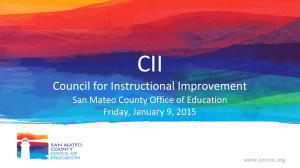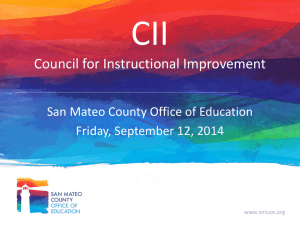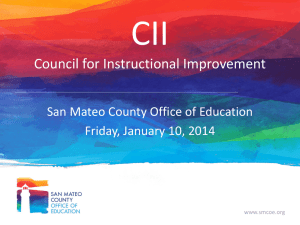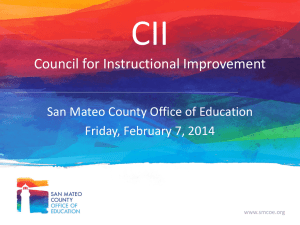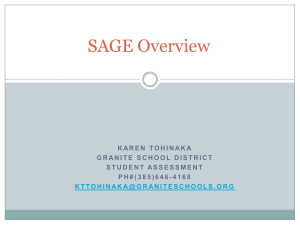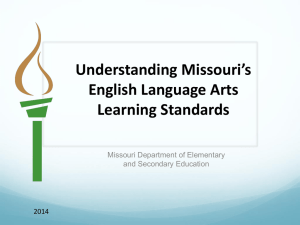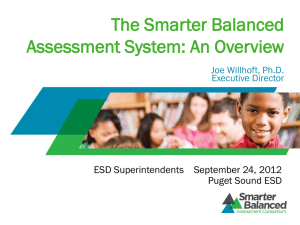PowerPoint - Smcoe.org
advertisement
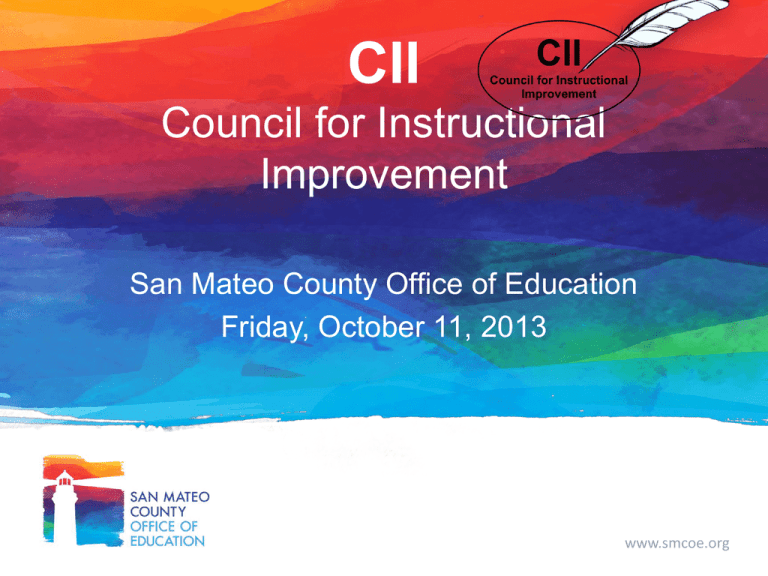
CII Council for Instructional Improvement San Mateo County Office of Education Friday, October 11, 2013 www.smcoe.org Agenda 8:30 WELCOME 8:40 STATE/FEDERAL UPDATES 9:25 ASSESSMENT AND ACCOUNTABILITY PLANNING FOR 2013-2014 10:25 BREAK 10:35 THE BIG LIFT 11:30 ADJOURN www.smcoe.org A Legislative Report: California Assessment G a r y Wa d d e l l , E d . D . Deputy Superintendent Instructional Services Division www.smcoe.org Bill Status – Assembly Bill 484 ( Bonilla) – Senate Bill 201 (Liu) – Senate Bill 247 (Liu) 4 www.smcoe.org Assembly Bill 484 • Establishes purpose of assessment system • Establishes Measurement of Academic Performance and Progress (MAPP) • Outlines assessments included in MAPP • Establishes field test parameters • Allows LEAs space to focus on Common Core State Standards • Allows low-stakes exposure to SBAC 5 www.smcoe.org Assembly Bill 484 • Early Entrance Program (EAP) • English Learners • Planning for other assessments and assessment modalities • The state to provide SBAC digital library to all LEAs • Federal waiver issue 6 www.smcoe.org AB 484: Required and Optional Assessments 2013-14 7 www.smcoe.org AB 484: Accountability, Score Use, and Evaluation • State Superintendent, with State Board approval, will not produce an Academic Performance Index in 2013-14 and 2014-15 • Restricts comparison of scores from MAPP and STAR • Prohibits display of scores that would identify students or teachers 8 www.smcoe.org Field Test Purpose “A field test is not designed to be a valid and reliable measure of student achievement; rather, it is designed to help the test developers evaluate whether the tests, individual items, and the technology platform work as intended before the first operational administration.” Deborah S. Delisle, U.S. Department of Education 9 www.smcoe.org Smarter Balanced Spring 2014 Field Test • March 18 – June 6, 2014 • Specific school and student sampling structure is under development (AB 484 requires Superintendent to develop a plan) • Scientific sample comprised of 20% (10% ELA and 10% mathematics) of students across consortium states • Data from the sample will be used to determine item reliability and validity and initial performance level scores • All other students will participate by taking EITHER an ELA or Mathematics Smarter Balanced field test www.smcoe.org Benefits of Field Test Participation • Students: will have hands-on experience with the functionality of a computer-based assessment • Teachers and administrators: will gain valuable exposure to administration logistics during a trial run • LEAs: will benefit from knowing where technology gaps may exist to fully prepare for operational assessments www.smcoe.org Smarter Balanced Assessment Consortium • Usability • Accessibility • Accommodation www.smcoe.org Senate Bill 201 (Liu) English Language Proficiency Assessments for California (ELPAC) Instructional materials Senate Bill 247 (Liu) Grade 2 diagnostic assessment www.smcoe.org Questions? www.smcoe.org Assessment and Accountability Planning Brian Simmons Director, Accountability, Innovation, and Results www.smcoe.org Outcomes Participants will… • Re-examine a “Balanced and Coherent System of Assessment” & its relationship to the emergent SBAC assessments • Diagnose their district’s/schools’ readiness for SBAC implementation and identify areas of strength and for further growth/learning • Identify common assessments that will be used to measure, monitor and report progress to stakeholders www.smcoe.org Agenda 1. A Balanced and Coherent System of Assessment: Some Reminders 2. Systems assessment – Where is your organization regarding the SBAC transition? 3. Common assessments/reporting in a “CST-free” zone www.smcoe.org CST Learning… • What have you learned (good or bad) about assessment from your CST experience: • • • • Preparing students Administering high-stakes tests Analyzing/using CST data? Educator PD regarding assessment • What lessons should we take forward into our work to implement the Smarter Balanced Assessment Consortium Assessments? www.smcoe.org Data Analysis Lessons from NCLB-Era “Data Analysis and the Next Generation Assessments,” Pon, Kathy.Leadership (ACSA) Jan./Feb. 2013 (p. 30-35) Lessons learned: 1. Assessment items have an influence on teachers’ discussions about student understanding 2. Data analysis using inquiry-based protocols and facilitators promote effective analysis of student assessment information www.smcoe.org Data Analysis Lessons from NCLB-Era “Data Analysis and the Next Generation Assessments,” Pon, Kathy. Leadership (ACSA) Jan./Feb. 2013 (p. 30-35) Lessons learned: 3. Teacher reflection that focuses on understanding student thinking supports and informs instructional decisions 4. Data analysis must be connected to powerful instructional or programmatic modifications 5. The effective use of data is best supported by the strategic distribution of leadership throughout a district www.smcoe.org A Balanced and Coherent System of Assessment District School Classroom www.smcoe.org A Balanced System of Assessment Large Scale (Assessment of) Mid-Scale (Assessment for) Small-Scale (Assessment for) • • • • • Formative processes with summative information • Criterion-referenced • Often teacher or district-made • Achievement • Questioning • Achievement Summative in nature Norm referenced Aptitude Achievement Essential Question: What have students already learned? Essential Question: How can we help students learn more? Essential Question: How can we help students learn more? www.smcoe.org Formative and Summative Assessment • Formative and summative assessments are interconnected. They seldom stand alone in construction or effect. • The vast majority of genuine formative assessment is informal, with interactive and timely feedback and response. • It is widely and empirically argued that formative assessment has the greatest impact on learning and achievement. www.smcoe.org Formative vs. Summative Assessment • Formative: FOR learning. It is taken at varying intervals throughout a course to provide information and feedback that will help improve the quality of student learning and the quality of the course itself. Formative assessment provides information on what an individual student needs to practice, to have re-taught, and what to learn next. • Summative: OF learning. It is generally taken by students at the end of a unit, semester, or year to demonstrate the “sum” of what they have or have not learned. www.smcoe.org A Balanced System of Assessment: SBAC Summative Accountability Assessment Optional Interim Assessment Bank Formative Assessment Practices • Grades 3-8 and 11 • Uses non-secure • Research-based on• Secure items/tasks; items/tasks; purpose demand resources for used for high school to monitor progress teachers to enhance accountability and toward college-career classroom assessment student readiness readiness activities indicator • Results placed on same • Professional • Includes “up to” 6 scale as summative development materials performance tasks (3 in • Includes performance include model units of ELA, 3 in math) to be tasks instruction and completed by end of assessment items, 11th grade formative strategies • May be taken twice www.smcoe.org How SBAC-Ready is your organization? • We will use CDE’s Guiding Strategy #3 (Transition to New Assessment Systems) to review one version of ideal and www.smcoe.org CDE Guiding Strategies • Awareness • Transition • Implementation • Sustaining www.smcoe.org Self Assessment 1. Underline items your district has accomplished thus far and calibrate/share with your table 2. Note items to still be accomplished 3. Discuss your assessment with a neighbor 4. Be prepared to share out common issues if time permits www.smcoe.org RESOURCES: CDE’s Data Literacy Module Brokers of Expertise has a new CCSS Assessment Literacy module that is freely available RESOURCES: Kenji Hakuta Discussing Preparing EL’s for the CCSS www.smcoe.org How will we report standards-based progress for the next 18 months? www.smcoe.org LCAP Eight Priority Areas 1. 2. 3. 4. 5. 6. 7. 8. Student Achievement Student Engagement Other Student Outcomes School Climate Parental Involvement Basic Services Implementation of CCSS Course Access www.smcoe.org Student Achievement Data • • • • Performance on standardized tests (Title I) Score on API Share of students that are college/career ready Share of English Learners that become English Proficient (Title III) • EL reclassification rate (Title III) • Share of students that pass AP/IB exams • Share of students “college ready” on the Early Assessment Program (EAP) www.smcoe.org Progress that could be Measured/Shared with Stakeholders • • • • • Mathematics Assessment Resource Service (MARS) CCSS-aligned benchmark assessments in ELA/Math Standards-based grades Diagnostic assessments Access to higher-level course taking (where/when relevant) • Re-designation criteria (other than CST, of course) • Others? www.smcoe.org Discussion Turn to your table and… 1. Discuss what measures your district is planning to use with stakeholders 2. Identify any common measures 3. What will have to happen to make these measures more “legitimate” if you have questions about their standards-alignment? 4. Select one person in your group to share out www.smcoe.org District Assessment Learning Network • SBAC planning and support • Meeting Dates: – October 25, 2013 – December 12, 2013 – February 28, 2014 3-5 pm 3-5 pm 3-5 pm www.smcoe.org The Big Lift Jane Gardner & Joe Rodriguez Facilitators, Peninsula Partnership Leadership Council (PPLC) www.smcoe.org Thank you! www.smcoe.org
